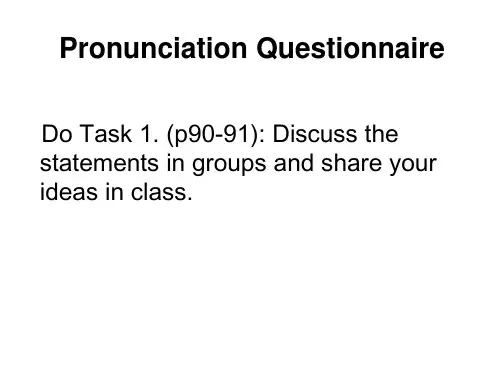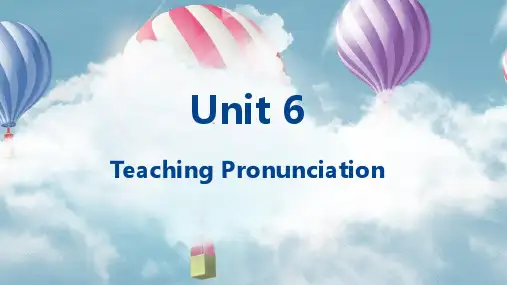英语教学法教程PPTunit6
- 格式:ppt
- 大小:2.68 MB
- 文档页数:57
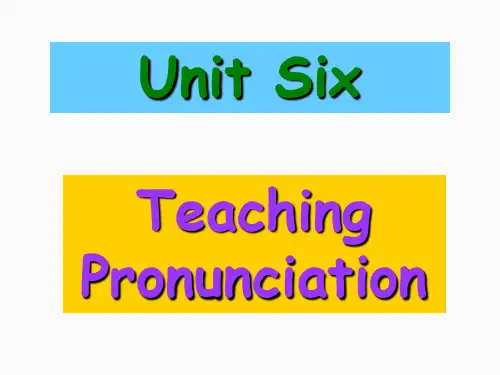
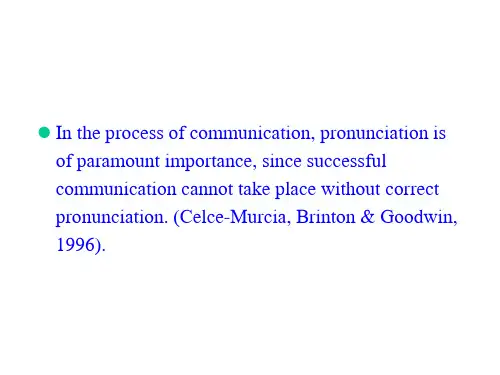
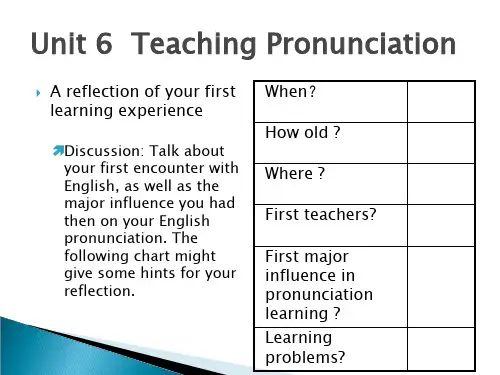

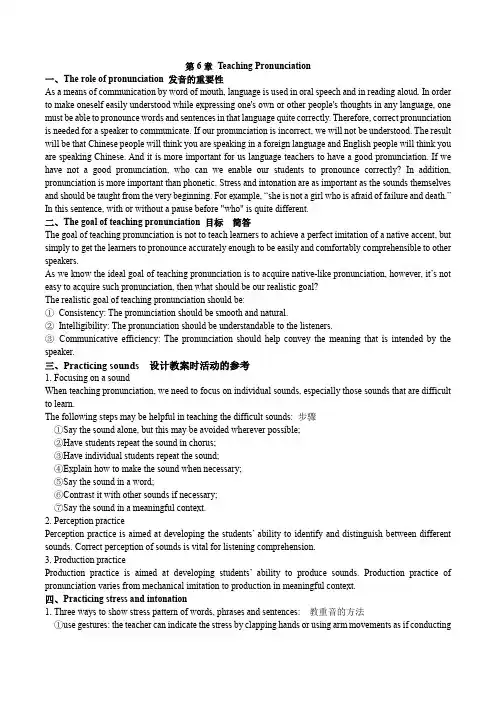
第6章Teaching Pronunciation一、The role of pronunciation 发音的重要性As a means of communication by word of mouth, language is used in oral speech and in reading aloud. In order to make oneself easily understood while expressing one's own or other people's thoughts in any language, one must be able to pronounce words and sentences in that language quite correctly. Therefore, correct pronunciation is needed for a speaker to communicate. If our pronunciation is incorrect, we will not be understood. The result will be that Chinese people will think you are speaking in a foreign language and English people will think you are speaking Chinese. And it is more important for us language teachers to have a good pronunciation. If we have not a good pronunciation, who can we enable our students to pronounce correctly? In addition, pronunciation is more important than phonetic. Stress and intonation are as important as the sounds themselves and should be taught from the very beginning. For example, “she is not a girl who is afraid of failure and death.” In this sentence, with or without a pause before "who" is quite different.二、The goal of teaching pronunciation 目标简答The goal of teaching pronunciation is not to teach learners to achieve a perfect imitation of a native accent, but simply to get the learners to pronounce accurately enough to be easily and comfortably comprehensible to other speakers.As we know the ideal goal of teaching pronunciation is to acquire native-like pronunciation, however, it’s not easy to acquire such pronunciation, then what should be our realistic goal?The realistic goal of teaching pronunciation should be:①Consistency: The pronunciation should be smooth and natural.②Intelligibility: The pronunciation should be understandable to the listeners.③Communicative efficiency: The pronunciation should help convey the meaning that is intended by the speaker.三、Practicing sounds 设计教案时活动的参考1. Focusing on a soundWhen teaching pronunciation, we need to focus on individual sounds, especially those sounds that are difficult to learn.The following steps may be helpful in teaching the difficult sounds: 步骤①Say the sound alone, but this may be avoided wherever possible;②Have students repeat the sound in chorus;③Have individual students repeat the sound;④Explain how to make the sound when necessary;⑤Say the sound in a word;⑥Contrast it with other sounds if necessary;⑦Say the sound in a meaningful context.2. Perception practicePerception practice is aimed at developing the students’ ability to identify and distinguish between different sounds. Correct perception of sounds is vital for listening comprehension.3. Production practiceProduction practice is aimed at developing students’ ability to produce sounds. Production practice of pronunciation varies from mechanical imitation to production in meaningful context.四、Practicing stress and intonation1. Three ways to show stress pattern of words, phrases and sentences: 教重音的方法①use gestures: the teacher can indicate the stress by clapping hands or using arm movements as if conductingmusic.②use the voice: the teacher can raise the voice to indicate stress. This can be done with some exaggeration sometimes.③use the blackboard: the teacher can highlight the stress parts by underlining them or writing them with colored chalks or in different size.2. Three ways to practice intonation:①use hand or arm movement to indicate change of intonation②use rising or falling arrows, such as ↗and↘.③draw lines五、Some suggestions on teaching pronunciation/How can teachers help the students to improve pronunciation? 教语音的建议或解决办法①Use individual, pair, group and whole class work to create a pleasant, relaxed, and dynamic classroom.②Use hands and arms to conduct practice.③Move around the classroom when doing choral practice.④Vary the criteria of ‘good’ to give students confidence.⑤Do articulation practice more than once.⑥Bring interests and variety to the practice.⑦The main criteria for good pronunciation are consistency, intelligibility and communicative efficiency.⑧Make full use of demonstrations.⑨Try to use visual aids.。
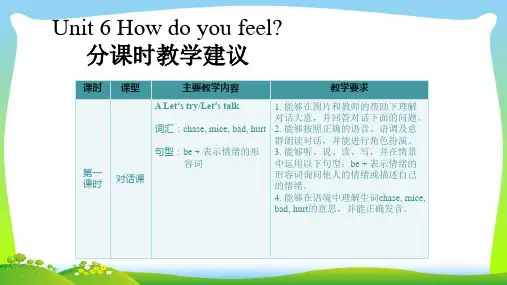
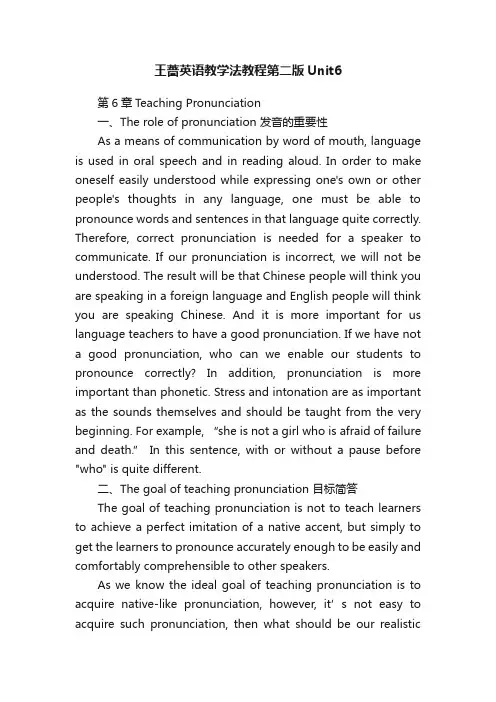
王蔷英语教学法教程第二版Unit6第6章Teaching Pronunciation一、The role of pronunciation 发音的重要性As a means of communication by word of mouth, language is used in oral speech and in reading aloud. In order to make oneself easily understood while expressing one's own or other people's thoughts in any language, one must be able to pronounce words and sentences in that language quite correctly. Therefore, correct pronunciation is needed for a speaker to communicate. If our pronunciation is incorrect, we will not be understood. The result will be that Chinese people will think you are speaking in a foreign language and English people will think you are speaking Chinese. And it is more important for us language teachers to have a good pronunciation. If we have not a good pronunciation, who can we enable our students to pronounce correctly? In addition, pronunciation is more important than phonetic. Stress and intonation are as important as the sounds themselves and should be taught from the very beginning. For example, “she is not a girl who is afraid of failure and death.” In this sentence, with or without a pause before "who" is quite different.二、The goal of teaching pronunciation 目标简答The goal of teaching pronunciation is not to teach learners to achieve a perfect imitation of a native accent, but simply to get the learners to pronounce accurately enough to be easily and comfortably comprehensible to other speakers.As we know the ideal goal of teaching pronunciation is to acquire native-like pronunciation, however, it’s not easy to acquire such pronunciation, then what should be our realisticgoal?The realistic goal of teaching pronunciation should be:①Consistency: The pronunciation should be smooth and natural.②Intelligibility: The pronunciation should be understandable to the listeners.③Communicative efficiency: The pronunciation should help convey the meaning that is intended by the speaker.三、Practicing sounds 设计教案时活动的参考1. Focusing on a soundWhen teaching pronunciation, we need to focus on individual sounds, especially those sounds that are difficult to learn.The following steps may be helpful in teaching the difficult sounds: 步骤①Say the sound alone, but this may be avoided wherever possible;②Hav e students repeat the sound in chorus;③Have individual students repeat the sound;④Explain how to make the sound when necessary;⑤Say the sound in a word;⑥Contrast it with other sounds if necessary;⑦Say the sound in a meaningful context.2. Perception practicePerception practice is aimed at developing the students’ ability to identify and distinguish between different sounds. Correct perception of sounds is vital for listening comprehension.3. Production practiceProduction practice is aimed at develo ping students’ ability to produce sounds. Production practice of pronunciation variesfrom mechanical imitation to production in meaningful context.四、Practicing stress and intonation1. Three ways to show stress pattern of words, phrases and sentences: 教重音的方法①use gestures: the teacher can indicate the stress by clapping hands or using arm movements as if conducting music.②use the voice: the teacher can raise the voice to indicate stress. This can be done with some exaggeration sometimes.③use the blackbo ard: the teacher can highlight the stress parts by underlining them or writing them with colored chalks or in different size.2. Three ways to practice intonation:①use hand or arm movement to indicate change of intonation②use rising or falling arrows, such as ↗and↘.③draw lines五、Some suggestions on teaching pronunciation/How can teachers help the students to improve pronunciation? 教语音的建议或解决办法①Use individual, pair, group and whole class work to createa pleasant, relaxed, and dynamic classroom.②Use hand s and arms to conduct practice.③Move around the classroom when doing choral practice.④Vary the criteria of ‘good’ to give students confidence.⑤Do articulation practice more than once.⑥Bring interests and variety to the practice.⑦The main criteria for good pronunciation are consistency, intelligibility and communicative efficiency.⑧Make full use of demonstrations.⑨Try to use visual aids.。
